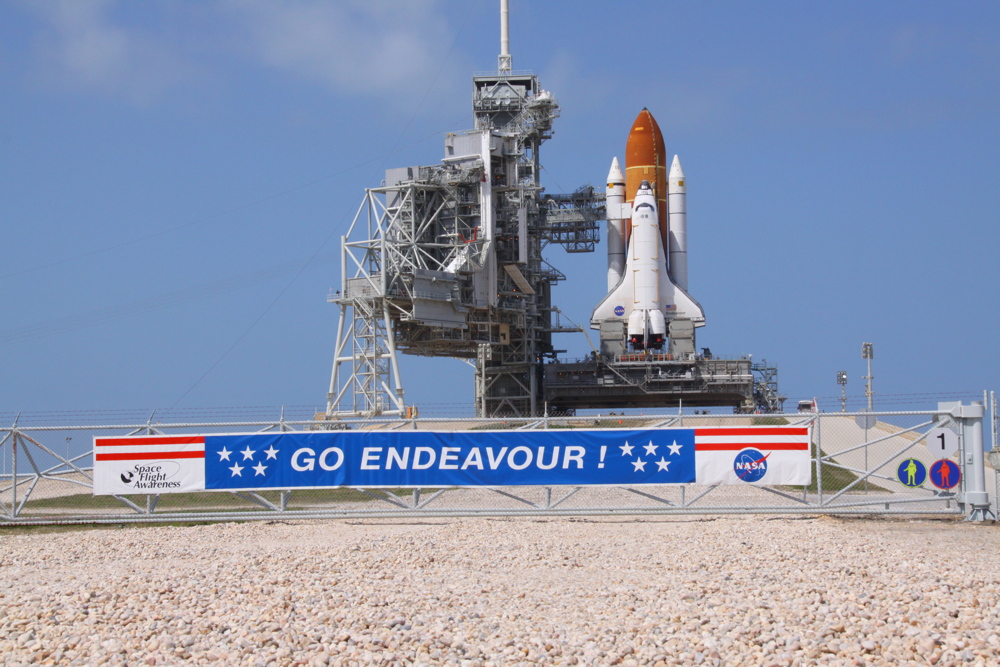
NASA's space shuttle Endeavour is set to launch Friday (April 29) on its final spaceflight, and record crowds — including President Barack Obama — are expected to see the orbiter off.
On its STS-134 mission, Endeavour will deliver a $1.5 billion astrophysics experiment to the International Space Station. It will also drop off some supplies to help outfit the orbiting lab for the post-shuttle era, which begins after Atlantis' STS-135 mission this summer.
Here are a few interesting facts about Endeavour as the orbiter prepares to blast into space for the last time:
1. It's the baby of the shuttle family
Endeavour is the youngest member of NASA's space shuttle fleet. The orbiter was built as a replacement for the shuttle Challenger, which was lost in the 1986 accident that also killed its seven-astronaut crew.
Congress authorized the construction of Endeavour — NASA's fifth spacegoing shuttle — in 1987, and the orbiter first blasted off in 1992. Friday's launch will initiate Endeavour's 25th space mission.
2. It was named by students
Get the Space.com Newsletter
Breaking space news, the latest updates on rocket launches, skywatching events and more!
Endeavour is the only shuttle to have been named by children. In 1988, NASA staged a national competition among elementary and secondary school students to hang a name on the new shuttle. The kids were given some guidance — the name had to be based on a historic oceangoing research or exploration vessel.
Then-president George H.W. Bush announced the winning name in May 1989. The shuttle's namesake, H.M.S. Endeavour, was commanded by Britain's James Cook on his epic 18th-century voyage of discovery in the South Pacific (hence the orbiter's British spelling).
3. Endeavour was built on the cheap — sort of
While Endeavour debuted a fair amount of new gear — it was the first shuttle to use a drag parachute during landing, for example, and it featured advanced avionics systems — much of the orbiter was built from spare parts. [Infographic: How Endeavour Was Built From Spare Parts]
These pieces were left over from the construction of the shuttles Discovery and Atlantis. This recycling ethic helped keep Endeavour's construction costs down to $1.7 billion, according to NASA officials.
4. It helped save the Hubble Space Telescope
Shortly after NASA's Hubble Space Telescope launched in 1990, scientists noticed that the instrument's images were a bit blurry. In 1993, Endeavour launched on its STS-61 flight — the first Hubble servicing mission — to fix the problem.
In a series of complex operations involving multiple spacewalks, Endeavour's astronaut crew swapped out some of Hubble's optics and other gear. Soon the telescope was seeing the universe in crisp, sharp detail.
"Without that mission, Hubble would be rather useless in orbit," said space-history expert Robert Pearlman, editor of collectSPACE.com (which is a SPACE.com partner). Endeavour, he added, "more or less saved Hubble and helped give it the legacy it has today."
5. Endeavour brought the International Space Station into being
The International Space Station can date its birth to Endeavour's STS-88 mission in December 1998. This mission took the first American component of the station — the Unity node, the passageway that connects the working and living modules — to space and joined it to the Russian Zarya module, which was already in orbit.
"By attaching Unity, it became a space station, and an international one at that," Pearlman told SPACE.com.
On its STS-134 mission, Endeavour will make another significant contribution to the ISS, delivering the final big piece yet to be added to the station from the American side — the $1.5 billion Alpha Magnetic Spectrometer physics experiment. [Video: Endeavour's Final Mission]
"Endeavour sort of bookends the International Space Station assembly," Pearlman said.
6. It's a change agent
Endeavour's second flight, the STS-47 mission back in 1992, broke new ground sociologically. Its crew featured the first African-American woman to fly in space (Mae Jemison), the shuttle's first Japanese astronaut (Mamoru Mohri) and the first married couple to fly on the same space mission (Mark Lee and Jan Davis).
So Endeavour will have a lot to be proud of when it returns to Earth in May and prepares to head out to sunny California for retirement. NASA awarded the shuttle to the California Science Center in Los Angeles, where crowds will be able to see the agency's youngest orbiter up close.
You can follow SPACE.com senior writer Mike Wall on Twitter: @michaeldwall. Follow SPACE.com for the latest in space science and exploration news on Twitter @Spacedotcom and on Facebook.
Join our Space Forums to keep talking space on the latest missions, night sky and more! And if you have a news tip, correction or comment, let us know at: community@space.com.

Michael Wall is a Senior Space Writer with Space.com and joined the team in 2010. He primarily covers exoplanets, spaceflight and military space, but has been known to dabble in the space art beat. His book about the search for alien life, "Out There," was published on Nov. 13, 2018. Before becoming a science writer, Michael worked as a herpetologist and wildlife biologist. He has a Ph.D. in evolutionary biology from the University of Sydney, Australia, a bachelor's degree from the University of Arizona, and a graduate certificate in science writing from the University of California, Santa Cruz. To find out what his latest project is, you can follow Michael on Twitter.










